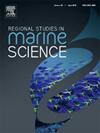预测混合模型在佛罗里达州的雪卡泰中毒趋势
IF 2.4
4区 环境科学与生态学
Q3 ECOLOGY
引用次数: 0
摘要
本研究的目的是确定雪卡毒素中毒的最佳预测模型,并确定哪些变量和时间滞后最能解释2006年至2020年佛罗里达州报告的病例数量。雪卡毒素中毒是一种因食用被雪卡毒素污染的珊瑚礁鱼类而导致的身体虚弱的情况。雪卡毒素来自产生毒素的鞭毛藻,并通过食物链进行生物放大。在严重的情况下,这种疾病可能是致命的。预计全球气候变化将增加雪卡毒素中毒的发病率及其地理范围,从热带和亚热带珊瑚礁延伸到温带地区。这使得了解和预测其动态变得尤为紧迫,因为全世界数百万人都以珊瑚鱼为主食。为了满足这一需求,我们开发了一种将小波交叉相干分析与计数建模框架相结合的综合方法。候选预测指标包括琥珀鱼、红鲷鱼、红石斑鱼和斯坎普石斑鱼的月累计登陆量;热带气旋数目;最高海洋温度;降水;季节;以及佛罗里达州的人口。所确定的最优模型为零膨胀负二项模型。结果显示,雪卡中毒病例与(i)最高海洋温度、(ii)风暴频率、(iii)鱼类登陆量和(iv)人口规模呈正相关,与降水呈负相关。通过建立一个强大的预测框架,本研究促进了对雪卡毒素中毒的环境和人为驱动因素的理解。这些发现为预测疾病爆发提供了基础,并为渔业和公共卫生机构提供了可行的见解,旨在降低佛罗里达州居民和游客的风险。本文章由计算机程序翻译,如有差异,请以英文原文为准。
Ciguatera poisoning trends in Florida using a predictive hybrid model
The aim of this study is to identify an optimal predictive model for ciguatera poisoning and to determine which variables and time lags best explain the number of cases reported in Florida between 2006 and 2020. Ciguatera poisoning is a debilitating condition caused by consuming coral reef fish contaminated with ciguatoxins, which originate from toxin-producing dinoflagellates and biomagnify through the food chain. In severe cases, the illness can be fatal. Global climate change is expected to increase both the incidence of ciguatera poisoning and its geographic range, extending from tropical and subtropical reefs into temperate regions. This makes understanding and predicting its dynamics particularly urgent, as millions of people worldwide depend on reef fish as a dietary staple. To address this need, we developed an integrated approach combining wavelet cross-coherence analysis with a count modeling framework. Candidate predictors included cumulative monthly landings of Amberjack, Red Snapper, Red Grouper, and Scamp Grouper; the number of tropical cyclones; maximum ocean temperatures; precipitation; season; and Florida’s human population. The optimal model identified was a Zero-Inflated Negative Binomial model. Results showed positive associations between ciguatera cases and (i) maximum ocean temperatures, (ii) storm frequency, (iii) fish landings, and (iv) human population size, alongside a negative relationship with precipitation. By establishing a robust predictive framework, this study advances understanding of the environmental and anthropogenic drivers of ciguatera poisoning. The findings provide a foundation for forecasting outbreaks and offer actionable insights to fisheries and public health agencies aiming to reduce risks for Florida residents and tourists.
求助全文
通过发布文献求助,成功后即可免费获取论文全文。
去求助
来源期刊

Regional Studies in Marine Science
Agricultural and Biological Sciences-Ecology, Evolution, Behavior and Systematics
CiteScore
3.90
自引率
4.80%
发文量
336
审稿时长
69 days
期刊介绍:
REGIONAL STUDIES IN MARINE SCIENCE will publish scientifically sound papers on regional aspects of maritime and marine resources in estuaries, coastal zones, continental shelf, the seas and oceans.
 求助内容:
求助内容: 应助结果提醒方式:
应助结果提醒方式:


